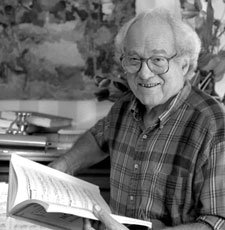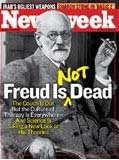
William Sloan Coffin in His Own words:
"Not to Bring Peace, But a Sword" Let's start by recognizing that there is a fundamental, unacceptability about unpleasant truth. We all shield ourselves against its wounding accuracy. Not only do we do this as individuals, but we do this as a people, as a nation. Twenty-seven hundred years ago, as some of you may remember, not because you were there, but because you read the Bible, the priest Amaziah said of the prophet Amos, "...the land is not able to bear all his words."
Every prophet has realized that nobody loves you for being the enemy of their illusions. Every prophet has realized that most of us want peace at any price as long as the peace is ours and somebody else pays the price. That is why the prophet Jeremiah said, "'Peace, peace,' they say, when there is no peace." and why Jesus said, "Do not suppose that I have come to bring peace to the earth. I did not come to bring peace, but a sword." (Matthew 10:34 NIV)
Full text of this sermon can be found at the following link:
http://www.30goodminutes.org/csec/sermon/coffin_3519.htm"The Glory of God is a human being fully alive." IrenaeusThe Rev. COFFIN: I'd just as soon live a little bit longer. But when you are 80, you can't complain. Joy in this world comes from self-fulfillment. Joy is a more profound experience than mere happiness. When you feel a sense of undeserved integrity because you think you're in the right fight -- against segregation, against the war in Vietnam, against the stupid and cruel discrimination against gays and lesbians -- these are the right fights, I feel very deeply. And the sense of self-fulfillment which comes from being in the right fight is a wonderful thing.
I remain hopeful. The opposite of hope is despair -- not pessimism, despair. And as a very convinced Christian, I say to myself, "Come on, Coffin. If Christ never allowed his soul to be cornered with despair, and his was the greatest miscarriage of justice maybe in the world, who the hell am I to say I'm going to despair a bit?"
When you get older, friendship obviously runs deeper and deeper. And, I would add, nature gets more interesting the nearer you get to joining it, and also more beautiful. I can sit on the front porch here and watch the sun coming in through the maple leaves. You know, God is good.
Interview with Rev. William Sloan Coffin from Religion & Ethics Newsweekly, August 2004:
http://www.pbs.org/wnet/religionandethics/week752/profile.htmlIn our time all it takes for evil to flourish is for a few good men to be a little wrong and have a great deal of power, and for the vast majority of their fellow citizens to remain indifferent." — In the Yale Alumni magazine in 1967
The U.S. government should have vowed "...to see justice done, but by the force of law only, never by the law of force." — After September 11, 2001
"We yearned for a revolution of imagination and compassion that would oppose the very aggressiveness and antagonism that characterized the actions of both Nixon and the Weathermen. We were convinced nonviolence was more revolutionary than violence" — referring to the organizers of the Moratorium to End the War in Vietnam
"Without love violence will change the world; it will change it into a more violent one." — June 1968
"It's too bad that one has to conceive of sports as being the only arena where risks are, [for] all of life is risk exercise. That's the only way to live more freely, and more interestingly."
"The world is too dangerous for anything but truth and too small for anything but love."
"Every nation makes decisions based on self-interest and defends them on the basis of morality." — to the Yale Class of 1968 35th reunion, May 2003
"Even if you win the rat race, you're still a rat."
Books
· Letters to a Young Doubter, Westminster John Knox Press, July 2005, ISBN 0664229298 (review and article from CommonDreams.org)
· Credo, Westminster John Knox Press, December 2003, ISBN 0664227074
· The Heart Is a Little to the Left: Essays on Public Morality, Dartmouth College, 1st edition, October 1999, ISBN 0874519586
· The Courage to Love, sermons, Harper & Row, c1982, ISBN 0060615087
· Once to Every Man: A Memoir, autobiography, Athenaeum Press, 1977, ISBN 0689108117











